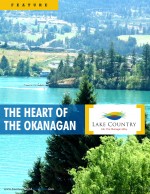
The Heart of the Okanagan
District of Lake Country takes pride in planning its work, working its plans

It’s only been 19 years since the District of Lake Country became an incorporated entity.
But – in keeping with Kevin Costner’s signature line – now that they’ve built it, the people are coming.
And they’re keeping both Ryan Roycroft and Greg Buchholz plenty busy.
“For a number of years we’ve been one of the fastest-growing small municipalities in British Columbia,†said Roycroft, the district’s economic development manager. “We had one year where we exceeded 8 percent growth and several others where we were north of 4 percent.â€
Indeed, the district’s population in the census taken just a year after incorporation was 9,007, and it showed little marked change in either the 2001 or 2006 federal counts – rising 2.9 percent to 9.267 for the former and climbing 3.7 percent to 9,606 for the latter.
The big spike occurred from 2006 to 2011, when a 21.9 percent boost raised the total to 11,708.
Thanks to a lot of new development in the area, Buchholz said much of the population growth has been skewing younger in age – which makes Lake Country one of the few places in either the Okanagan Valley region or the British Columbia province as a whole whose median age is going down.
And the changing expectations of that changing population creates a need for infrastructure to keep up, which creates additional responsibility for Buchholz, the district’s director of infrastructure services.
“Prior to incorporation, there was sort of nominal population change in the area, and one of the things the new council began to grapple with was creating an environment where population and economic growth could occur,†he said. “The whole province saw significant increases, and with the district being a very desirable area – with our sunny Okanagan climate – we were targeted as a place to develop.â€
Roycroft said the development has consisted primarily on the residential side, largely fueled by people who work in the nearby cities of Kelowna (about 30 minutes south) or Vernon (roughly 30 minutes north) and are seeking a “four-season playground†to bolster their quality of non-work life.
Other potential enticements include convenient access to the Kelowna International Airport, post-secondary educational opportunities at either the University of British Columbia’s Okanagan campus or the two campuses of Okanagan College, and shopping and cultural offerings in adjacent towns.
About 60 percent of the migration to the district is from within British Columbia, Roycroft said, while the remaining 40 percent is arriving from elsewhere in Canada – typically Alberta. The oil and gas industry has contributed to population growth as well, with as many as 500 district residents – and 10,000 in the valley region as a whole – making their homes locally in between work stints near Fort McMurray.
“When it’s at 8 percent growth, it’s a bit hairy,†Roycroft said.
“We’re at a more stable level now. It’s very exciting, because one of the big areas we’re looking at is economic development. We like taking a partnership approach with our developers, so it allows us to advance the infrastructure that benefits both the development and the existing residents. If done right, it can help with our tax base, as long as we’re being careful to avoid sprawl and these types of things.
“It comes with challenges. But like anything else, you just have to manage them.â€
Adding staff and restructuring roles within municipal departments has helped the district cope, Buchholz said, but the biggest advantage amid the growth phase is the staff’s inherent lean toward efficiency.
“On a per-capita basis, we move a lot of water and we have a lot of roads to maintain,†he said.
“We move almost as much water as the city of Kelowna, and we have a service population of 10,000 while they have a service population of 65,000. That creates some real challenges for us in terms of funding our infrastructure, because we’re taking that burden without as many people paying into it.â€
Buchholz said an asset management plan was completed in 2010 that both assessed existing infrastructure and began the planning process of what will be needed to address future population growth. He said the study suggested the district’s water and roads infrastructure were each being underfunded by $2 million annually, while the third gap revolved a dearth of inventory knowledge about the local drainage systems – let alone a status report of the condition of those systems.
A subsequent water master plan in 2012 addressed the infrastructure gap in water and established an $80 million capital program over the next 20 years, which necessitated a bump in annual water rates from $480 to $730 over a five-year phase-in period. The roads are the topic of another 20-year plan, called “Transportation for Tomorrow,†which is nearly complete and has thus far narrowed the road-centric infrastructure gap by $700,000, with more work to do regarding funding sources.
A storm water master process is also under way, which, Buchholz said, is allowing the district to “go out and figure what have we’ve got, where is it and what kind of condition is it in.†When that assessment is complete, he said, the task will shift to pulling a plan together, but he characterized the remaining work as more “getting on top of things†rather than a “major economic hardship.â€
Among the infrastructure projects connected to the wave of planning are a universal metering initiative that’ll precede subsequent major improvements in water capacity and quality. The metering is intended to produce a 25-percent reduction in usage and is scheduled to be rolled out by the end of 2015.
Additionally, following a series of upgrades that brought in-district sewer service to 2,000 homes, an ongoing $7 million improvement project at the waste water treatment plant will double its capacity and enhance the potential for more local development while allowing for connections to 700 more existing homes in subdivisions that had previously been without service.
Funding via Infrastructure Canada’s “Building Canada Fund†is sought to offset the $20 million cost, and Buchholz doesn’t at all expect that the latest series of endeavors will be the last for a proactive staff.
“Maybe we’re small enough, but big enough,†he said.
“Small enough to still care and across the board want to make things happen, and big enough to actually make them happen. Everything rises and falls with leadership. We’ve had a lot of people within our organization and within this community that are very dedicated to making good things happen and making a difference.
“We’ve had some very strong champions.â€
AT A GLANCE
WHO: District of Lake Country
WHAT: Municipality consisting of four wards – Okanagan Centre, Carr’s Landing, Oyama and Winfield – that were home to 11,708 residents, according to the 2011 federal census
WHERE: Within the Okanagan Valley region of southern British Columbia, north of the city of Kelowna and south of the city of Vernon
WEBSITE: www.OkanaganWay.ca








